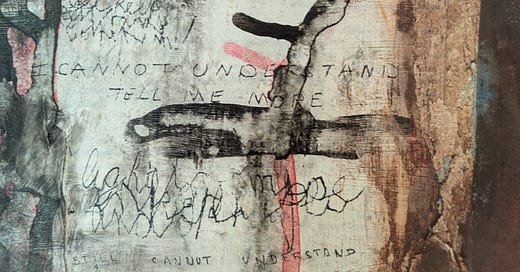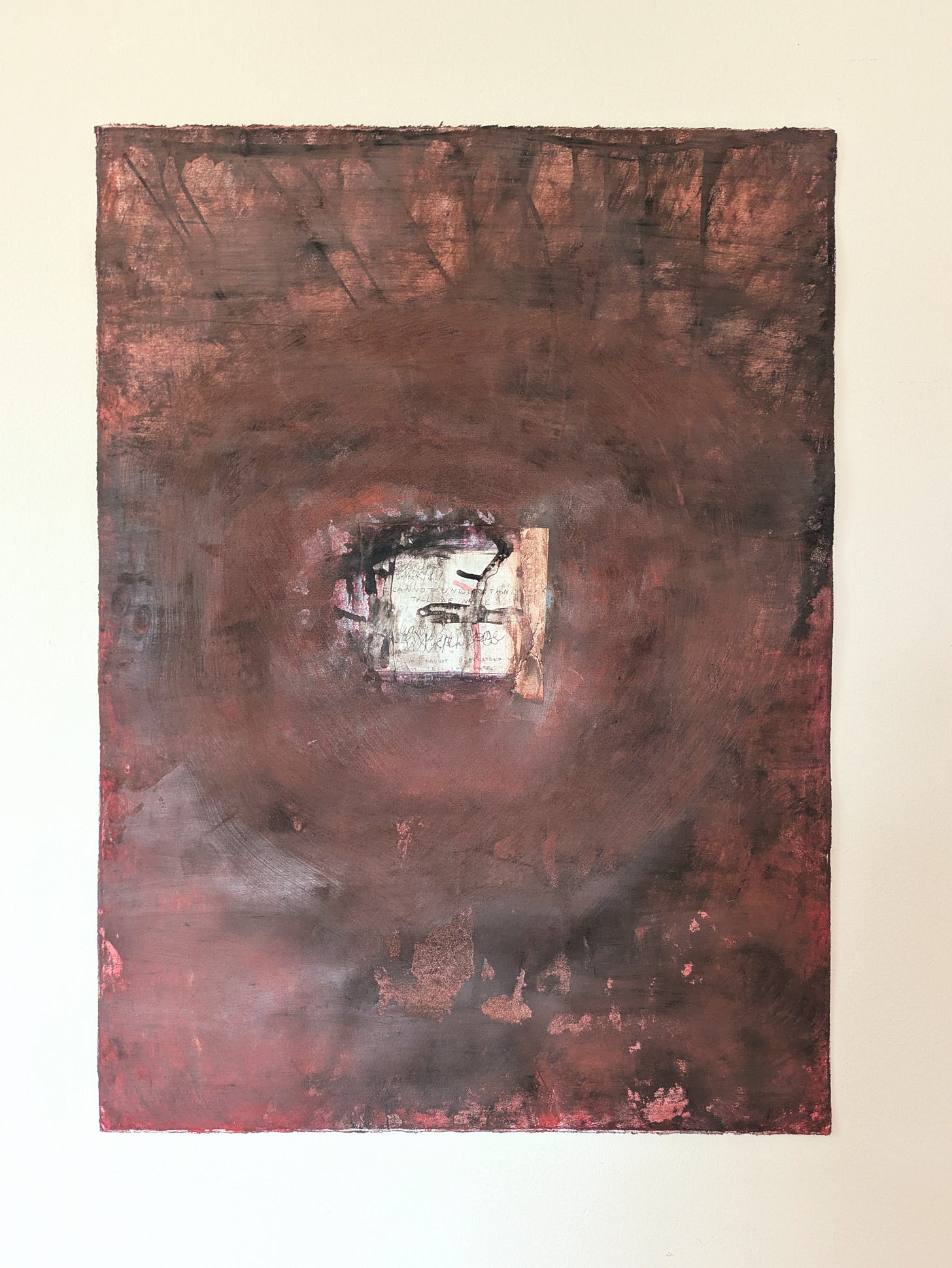I cannot understand tell me more
(un)armored hearts, Shambhala warriors, and cognitive dissonance
“…the battle is not between good people and bad people, for the line between good and evil runs through every human heart. We realize that we are interconnected, as in a web, and that each act with pure motivation affects the entire web, bringing consequences we cannot measure or even see.”
—Joanna Macy, The Shambhala Warrior
I made a painting this morning. In the center is embedded a scrap of paper. Torn from a book on Myth that I pulled out of my Little Free Library. A message from a poltergeist scrawled again and again.
I cannot understand tell me more
I still cannot understand please tell me more
Something in the scrap grabbed me, though I didn’t quite know why. Maybe because somewhere in me, I recognized these words.
When your body knows something — when the gut clenches or the heart aches. When there’s not yet language. Or maybe there is, but we don’t want to hear it.
The mind is refusing to know. It bargains, wants more data.
I cannot understand tell me more
I still cannot understand please tell me more
The overthinking, the rumination, the spirals. The what-if / the if-then / the but-I-can’t.
Do you have them too? Quiet and haunting, little voices inside at times, trying desperately to tell you things?
Is it that we cannot understand?
Or that we don’t want to?
I’m thinking about the hospital that was bombed this morning in Gaza, the children dying of starvation with food aid blocked, the fake ICE vests you can now order on Amazon so that anyone who wants can cosplay and terrorize their neighbors. And inside me, and you, perhaps, there still may be parts inside us that keep saying
I cannot understand tell me more
I still cannot understand please tell me more
Because the cognitive dissonance of knowing something is wrong — terribly wrong —but not knowing how to change it — or fearing that maybe you do know how to change it but you’d have to risk your safety and your comfort and your smallness — is so painful that we all (all of us, I think) sometimes just bury it.
The line between good and evil runs through every human heart
Inside my chest, under the skin, under the breastbone, made of something sturdier than bone, I feel it sometimes. A sheath of energy: a plate of armor.
A heart locked up tight.
What does it know? Where is it confused?
I cannot understand tell me more
I still cannot understand please tell me more
The armor doesn’t exactly hurt. It’s not tight like a waistband, something digging.
More: tight like a shipbuilder’s joints, snugged mortise and tenon, slathered in shellac. Something strong; something seaworthy.
At times it feels strong, to be armored.
Or this is what I tell myself.
Why all the armor?
Once upon a time there was a trust fall.
I was 16 years old, a camp counselor at a YMCA camp in Maine. We were in our staff training week, before the campers arrived. Learning the rules and routines. Ice-breakers and team-building.
Then we’re lining up and standing on a stage and trust-falling backwards like stage-divers all the way down into the linked arms of a line of counselors who are meant to catch us and surf-bounce us along like a sluice. We’re cookies on conveyor belt, one after another down the line of linked arms. Bounce, bounce, bounce.
Cookie, cookie, cookie, we’re supposed to chant.
The counselor before me is a six-foot-something heavyset dude with a beer belly and a loud chortle and a sunburned nose. Everyone groans, anticipating his weight, but they brace and they catch him and bounce him and it’s fine.
Then it’s me. And fucking okay fine. It feels stupid but I do it. Fall back.
Only maybe they’re not ready for something so small after something so heavy. They bounce me up into the sky and then just — flail, scatter. I slam six-feet down, land flat on my back. Wind knocked out. No breath.
No
breath
No
breath
stunned empty sky pain haze panic stuck-limbed silent
She’s bleeding! someone yells.
But I’m not. I just can’t breathe.
No one knows what to do. Finally the air enters my lungs and I roll over and climb to my feet and hobble to the bathroom alone. Every instinct in my body wants to cry but I think if I start it will become a screaming howl and I’ll never stop. So I swallow it.
What happens to a swallowed scream?
What happens to the pain we refuse to feel, or talk about?
Perhaps it becomes the armor.
Every time we open up, risk really feeling the pain, risk letting someone in: it’s a trust fall.
Get dropped too many times? And you turn skittish.
You crawl back into your shell.
Do this for a lifetime and it looks like a personality.
Do it for generations and it looks like culture.
I cannot understand tell me more
I still cannot understand please tell me more
But the body already knows. It knows what hurts. It sees the suffering of the world and longs to help.
What if the armor can be transformed?
Perhaps we were warriors in another lifetime. Perhaps we’ll be warriors again.
In Tibetan legend, in a time of great strife, the Shambhala warriors will remember who they are, and arise. Armed with two weapons: compassion and insight. The heat of a heart that burns with the pain of the world. The calm of the wisdom that knows all is impermanence, all is dependent co-arising. Change is the only law, and everything you do matters.
Perhaps you too have known an armored heart. The armor does what armor does: attempts to keep arrows from piercing. Attempts to keep out pain — to keep you alive, so you can keep fighting.
Head down / nose to the grindstone. Log on / show up / keep pushing / keep going. One foot in front of the other / can’t stop now / can’t slow down / keep going.
Ancestor upon ancestor. Like the shell of a tortoise, we carry it with us, the armor. Who knows how long it’s been there. Longer than this lifetime, maybe.
The trouble is, sometimes the armor does what armor doesn’t mean to do: blocks the open flow of love. Won’t let feeling in. Won’t let feeling out.
If the joints fail, and the sea gets in, the ship will sink. If the oceans rise / if the saltwater tears start flowing / you could drown forever in that abyss, couldn’t you? What if you start to cry and never stop? What if crying becomes all you are?
In Buddhist practice, the prescription to soften the heart’s armor is metta, loving-kindness meditation. It is traditionally practiced in widening circles. We begin with the self, offering these heartfelt wishes:
May I be happy
May I be safe
May I be free from suffering
May my path unfold with ease
It can be incredibly hard to take on these wishes.
The armor on the heart may dig in like sharp shards and beg stop, stop, it hurts.
What if you start to cry and never stop?
There may be blurts right behind the words in the skull But I don’t deserve to be happy. But I’m not safe, how can I be. But suffering is all I know. But what if it doesn’t. What if it’s always hard.
A practice that has been profound for me, at times when it’s challenging to practice for myself, is the “just like me” meditation.
Rather than practicing only for the self, we can imagine a group of people of which we are a member — all people who have lost a loved one, say. All people who are feeling scared and uncertain about the future. All those who want to help but who struggle to believe in themselves, or that anything we do can make a difference.
Picture them — how many people this would include. All their faces, all their homes, all their hopes, all their pain. Their favorite pair of jeans and their childhood pet.
And then for all of us, we can practice:
May we all be happy
May we all be safe
May we all be free from suffering
May our paths unfold with ease
Sometimes it’s easier to believe someone else deserves it, the compassion. The grace. The goodness.
But what if we all do?
In traditional metta, we begin with the self, and then move to practicing
for someone we know and love
and then further out toward someone we feel neutral towards, perhaps an acquaintance
and then further out, eventually, towards someone we have difficult feelings for
and eventually even further out, to practice for all beings.
And the point of this practice, as it was taught to me — like all mindfulness practice — isn’t to “get it right.” The point is to witness, with loving awareness, what our experience is.
It might just hurt. It might reveal to us the edges where we’re numb. That’s okay. That’s useful information.
Eventually, though, maybe after weeks or months, the heart might begin to soften.
The armor might learn then how to be a sheath of light, something that protects not with barriers, but with wisdom and compassion.
Box
by Joy Harjo
July 30, 2019 Tuesday at dusk.
This time I stopped a hurtful comment in time before it could enter my electrical skin. We have different layers of skins. I saw that the comment had a twist, meant to hurt. No, I told it. You cannot enter here. It got confused. It wanted to live. I could send it back. But I care about the sender. I don’t want her hurt. I put the arrow in a box. This box was made of words like dusk, kindness, gourd vines. This box of words will protect me. When I have understanding, then the box will disappear.
Poetry taught me this.
In this moment, on this day. An invitation to breathe, on purpose, even just for a moment.
we are interconnected, as in a web, and each act with pure motivation affects the entire web, bringing consequences we cannot measure or even see
If you don’t know what to do, you can begin by simply naming the truth that you don’t yet know. Open a crack of space.
Invite in the next hint of an answer.
May your path unfold with ease.





